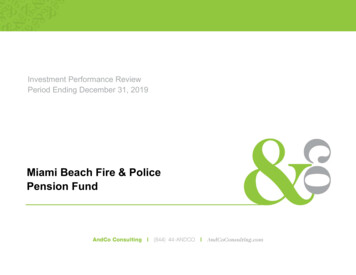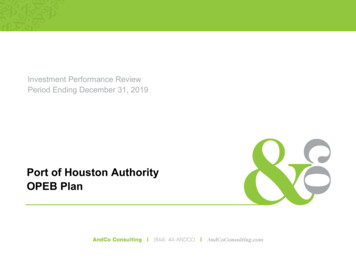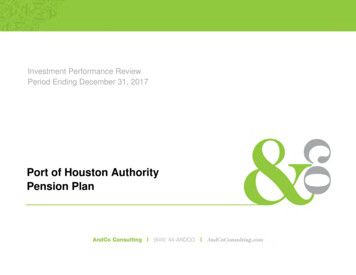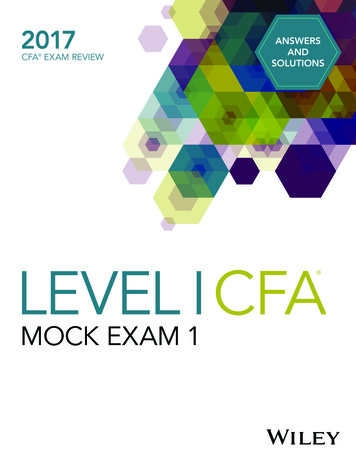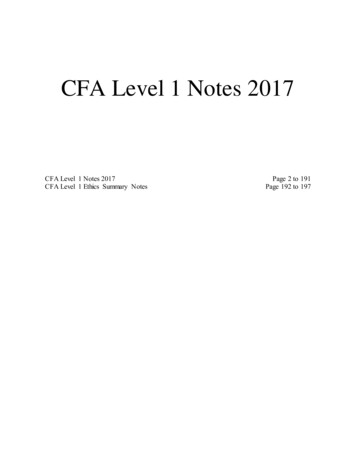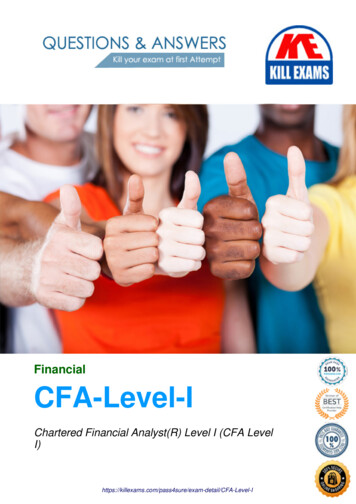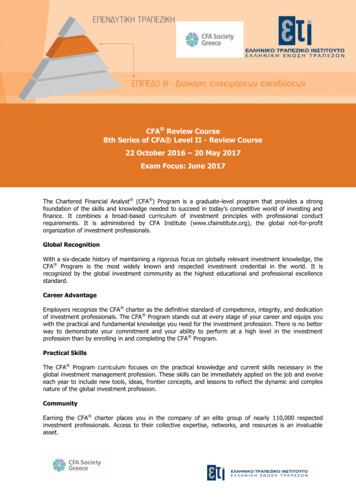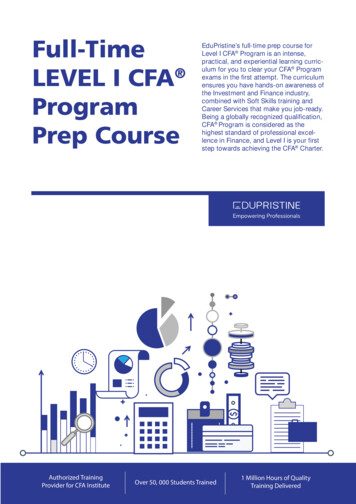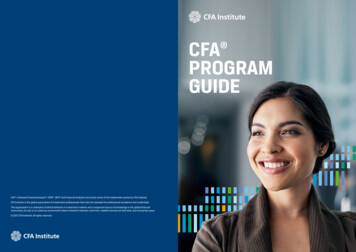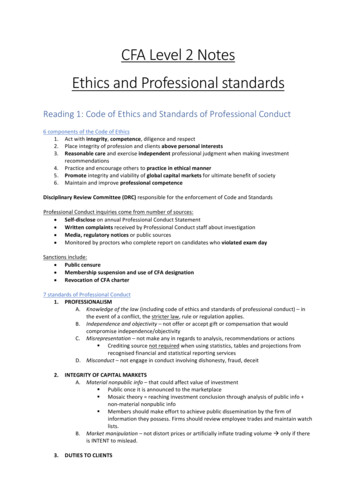
Transcription
CFA Level 2 NotesEthics and Professional standardsReading 1: Code of Ethics and Standards of Professional Conduct6 components of the Code of Ethics1. Act with integrity, competence, diligence and respect2. Place integrity of profession and clients above personal interests3. Reasonable care and exercise independent professional judgment when making investmentrecommendations4. Practice and encourage others to practice in ethical manner5. Promote integrity and viability of global capital markets for ultimate benefit of society6. Maintain and improve professional competenceDisciplinary Review Committee (DRC) responsible for the enforcement of Code and StandardsProfessional Conduct inquiries come from number of sources: Self-disclose on annual Professional Conduct Statement Written complaints received by Professional Conduct staff about investigation Media, regulatory notices or public sources Monitored by proctors who complete report on candidates who violated exam daySanctions include: Public censure Membership suspension and use of CFA designation Revocation of CFA charter7 standards of Professional Conduct1. PROFESSIONALISMA. Knowledge of the law (including code of ethics and standards of professional conduct) – inthe event of a conflict, the stricter law, rule or regulation applies.B. Independence and objectivity – not offer or accept gift or compensation that wouldcompromise independence/objectivityC. Misrepresentation – not make any in regards to analysis, recommendations or actions§ Crediting source not required when using statistics, tables and projections fromrecognised financial and statistical reporting servicesD. Misconduct – not engage in conduct involving dishonesty, fraud, deceit2.INTEGRITY OF CAPITAL MARKETSA. Material nonpublic info – that could affect value of investment§ Public once it is announced to the marketplace§ Mosaic theory reaching investment conclusion through analysis of public info non-material nonpublic info§ Members should make effort to achieve public dissemination by the firm ofinformation they possess. Firms should review employee trades and maintain watchlists.B. Market manipulation – not distort prices or artificially inflate trading volume à only if thereis INTENT to mislead.3.DUTIES TO CLIENTS
A. Loyalty, Prudence and Care – act in benefit of client, place clients interest beforeemployer’s/own interest§ Submit at least quarterly statements showing securities in custody and all debits,credit and transactions. Not vote on all proxies.B. Fair Dealing – dealing with clients when making analysis, recommendations, engagement§ E.g. do not take shares of an oversubscribe IPOC. Suitability – risk and return objectives, suitable investments, consistent with objectives andconstraints of portfolio§ Members gather info at beginning of relationship in the form of an investmentpolicy statement (IPS)D. Performance presentation – fair, accurate and complete§ Include terminated accounts and state when terminatedE. Preservation of confidentiality – keep info about clients (current and past) confidential unless3 exceptions: illegal activities, disclosure required by law, client permits disclosure4.DUTIES TO EMPLOYERSA. Loyalty – act for benefit of employer and not divulge confidential info§ No requirement to put employer interests ahead of family and personal obligations§ Violations include misappropriation of trade secrets and client lists, misuse ofconfidential info, soliciting employer’s clients, self-dealing.B. Additional Compensation Arrangements – not accept gifts, benefits that might create conflictof interest unless obtain written consent from all parties involved§ If client offers bonus depending on future performance, this is an compensationarrangement à requires written consent in advance§ If client offers bonus depending on past performance, this is a gift à requiresdisclosure to employer to comply with Standard I(B) Independence and ObjectivityC. Responsibilities of Supervisors – make sure people comply with laws, regulation and Codeand Standards5.INVESTMENT ANALYSIS, RECOMMENDATIONS AND ACTIONSA. Diligence and Reasonable Basis – reasonable basis supported by research and investigationfor analysis, recommendation§ Application depends on investment philosophy adhered to, members’ roles ininvestment decision making process, and resources and support provided byemployer§ Considerations include economic conditions, firms financial results/operatinghistory, fees and historical results, limitations of quant models, peer groupcomparisons for valuation are appropriate§ Members should encourage firm to adopt policy for periodic internal review ofrdquality of 3 party researchB. Communication with Clients – disclose basic principles of investment process and constructportfolios and any changes that might materially affect processes, significant limitations andrisks, identifying important factors and communicate them, distinguish between fact andopinion.§ Expectations based on modeling/analysis are not facts§ Communicate gains/losses in terms of total returns§ Explain limitations of model/assumptions used and of the investment itself – e.g.liquidity and capacityC. Record Retention – develop and maintain records to support analysis and recommendationwith clients (e.g. documenting details of convo)§ Member who changes firms must re-create analysis documentation supportingrecommendation and must not rely on material created at previous firm§ If no regulatory standards/firm policies in place, recommends 7-year minimumholding period6.CONFLICT OF INTEREST
A. Disclosure of Conflicts – matters that could impair independence and objectivity or interferewith duty to clients and employer§ E.g. ownership of stock in company that recommendingB. Priority of Transactions – clients/employers priority over own§ Limitations on employee participation in equity IPO, private placement§ Blackout period – no personal purchase/sale of security in advance ofclient/employerC. Referral Fees – compensation received or paid to others for recommendation ofproducts/services7.RESPONSIBLE AS A CFA INSTITUTE MEMBER/CANDIDATE1. Conduct as Participants in CFA Institute Programs – not compromise reputation or integrityof CFA§ e.g. exam cheating, improperly using designation, not reveal confidential inforegarding CFA, misrepresenting info on Professional Conduct Statement (PCS)2. Reference to CFA Institute, Designation and Program – not misrepresent or exaggeratemeaning/implications§ Members must sign the PCS annually, and pay CFA membership dues annually à iffail to do this, person will no longer be an active memberNo requirement to report violations to govt authorities, but is advisableReading 3: CFA Institute Research Objectivity StandardsObjectives of Research Objectivity StandardsObjective is to provide specific measureable standards for managing and disclosing conflicts of interest thatmay interfere with analyst ability to conduct independent research and make objective recommendations Clients interest before employees and firms Minimize possible conflicts which will affect independence and objectivity Support self regulation Provide work environment conducive to ethical behavior and adherence to Code and StandardsCompany policies & practices to research objectivity changes required vs recommended complianceResearch Objectivity Policy RequirementsFormal written independence andobjectivity of research policy distributed toclientsSupervisory procedures in placeSenior officer attesting annually to clients RecommendedIdentify covered employees (conductsresearch, takes investment action, ability toinfluence reports)Factors on which analysts compensationbasedHow reports may be purchased by clientsPublic AppearancesRequirementsRecommendedCovered employees making public Audience can make informed judgementappearances to discuss research or Prepared to disclose all conflicts and all IBinvestment recommendations mustand marketing relationshipsdisclose any personal and firms conflicts of Research reports should be provided at ainterestreasonable costsReasonable and Adequate BasisRequirementsRecommendedSingle employee or committee charged Firms providing guidance on whatwith reviewing and approving all reportsconstitutes reasonable and adequateand investment recommendations Provide supporting data to client
Investment Banking (IB)RequirementsRecommendedSeparate research analysts from IB dept Not sharing report with IB until publicationAnalyst NOT supervised by IB personnel IB personnel only review to verify factualinfo or identify possible conflict of interestPrevent IB from reviewing or approvingresearch reports and recommendations Analyst not allowed to participate inroadshowResearch Analyst Compensation RequirementsComp directly related to quality of researchand recommendations, and NOT linked toIB or corporate finance activities RecommendedMeasurable criteria consistently applied toall analystsDisclose extent to which compensation isdependent on IB revenueRelationship with Subject CompaniesRequirementsRecommendedAnalyst not allow subject company to see Governing r/ship with companies (e.g. gifts)any part of research that might signal Check facts contained before publicationrecommendation or make promises Legal dept receive draft before sharedPersonal Investment and TradingRequirementsRecommendedPolicies addressing personal trading of Interests of client ahead of personal & firmemployees Obtain approval from legal/compliancedepartment in advance of any tradingEnsuring employees do not share info withany one who could trade ahead Restricted periods for employee tradingProhibit employees and family from trading Contrary investment due to financialcontrary to recommendationshardship Provide list of personal holdingsTimeliness of Research Reports and RecommendationsRequirementsRecommendedRegularly issue research reports on subject Regular updates on research e.g. quarterlycompanies on a timely basis If company coverage discontinued, issue a“final” research reportCompliance and EnforcementRequirementsRecommendedDisciplinary action, monitoring Distribute client list of activities which areeffectiveness, maintain records for auditviolations and include disciplinary sanctionsDisclosure RequirementsDisclose conflict of interest related tocovered employees or firm as a whole Rating SystemRequirementsMust have rating system that investors find useful for investment decision thatdetermines suitability of investment RecommendedDisclosures complete & easy to understandDisclose valuation methods for price tgtsRecommendedAvoid 1-dimensional ratings à Need moreinfo description of system
Absolute (buy/hold/sell) or relative(outperform/underperform) categoriesrecommendedReading 7: Trade Allocation: Fair Dealing and DisclosureEvaluate trade allocation practices and determine if comply with Standards Allocation of client trades on ad-hoc basis lends itself to fairness problems:o Allocation may be based on compensation arrangements§ E.g. allocating disproportionately trades to performance-based fee accounts àbreaches III(A) as this increases fees at expense of asset-based fee accountso Allocation may be based client relationships with firm§ E.g. allocating disproportionate share of profitable trades to favored clientsDescribe appropriate actions to take in response to trade allocation practices that don’t respect client interests Advanced indication of client interest regarding new issues Distribute new issues by client, not by PM Fair and objective method for trade allocation such as pro rata system Execution of trades and price fairly in a timely and efficient manner Keeping records and periodically review to ensure clients treated equitablyReading 8: Changing Investment ObjectivesEvaluate disclosure of investment objective and policies Investment actions consistent with stated objectives and constraints of the fund Material deviation from process in absence of client approval violates III(C) Duties to Clients Investment must fit within mandate or within realm of investment that’s allowed according to fund’sdisclosure (e.g. prospectus or PDS)Actions needed to ensure adequate disclosure of investment process Determine clients financial situation, investment objectives and level of investing expertise Adequacy disclose security selection and portfolio construction process Conduct regular internal checks for compliance with these processes Stick to stated investment strategy if managing specific mandate or strategy Notify investors of potential change in process and secure documentation of authorization forproposed changes
Quantitative Methods for ValuationsReading 9: Correlation and RegressionSample covariance and sample correlation coefficientCovariance measures the degree of how 2 variables move together. ve move together. –ve opposite directions. 0 no relationship Limitations:o Sensitive to scale of two variableso Range from negative to positive infinityTherefore need to calculate correlation coefficientCorrelation coefficient (r) is a measure of strength of the linear relationship between 2 variables𝜌", 𝐶𝑜𝑣", 𝐶𝑜𝑣𝑎𝑟𝑖𝑎𝑛𝑐𝑒 𝜎" 𝜎 𝑆𝐷1 𝑆𝐷2 1 perfectly positively correlated. -1 perfectly negatively correlatedScatter plot is collection of points on a graph where each point represents values of 2 variables (X/Y pair)3 Limitations to correlation analysis1. Impact of outliers à i.e. extreme values2. Potential for spurious correlation à appearance of r/ship when there is none (i.e. chance)3. Correlation only measures linear, does not capture nonlinear relationshipTest of hypothesis that population correlation coefficient 0Need to know strength of relationship indicated by correlation coefficient by using statistical test ofsignificance2 Tailed test Null à H0: µ µ0 Alternate à Ha: µ µ0if normally distributed à use t-test to determine whether null should be rejectedr sample correlation coefficientDecision: compare t stat with critical t-value for appropriate degrees of freedom and significance level REJECT H0 if:o t stat upper CVo t stat lower CV if rejected à significantly different from 0Dependent vs independent variables in linear regressionSimple linear regression explains variation in dependent variable (predicted) in terms of variation inindependent variable (explanatory)6 Assumptions of linear regression1. Linear relationship exists b/w dependents and independent variable2. Independent variable uncorrelated with residuals3. Expected value of residual term is zero [E(ε) 0]4. Variance of residual term is constant for all observations
5.6.Residual term independently distributed à residual not correlated with any other observationsResidual term normally distributedSIMPLE LINEAR REGRESSION MODEL: Yi b0 b1Xi εi,b1 is the slope coefficient à Predicted change in dependent for 1 unit change in independent i.e. beta à measures systematic riskb0 is intercept term à i.e. ex-post alpha à measures excess risk-adjusted returnError term (εi) represents portion of dependent variable that cannot be explained by independent variableRegression is a line of best fit. It is the line for which estimates of b0 and b1 are such that sum of squareddifferences between estimated Y-values and actual Y-values is minimized à Sum of squared errors (SSE) Simple linear regression ordinary least squares (OLS) regressionNote: Hypothesis test or confidence interval needed to assess importance of variableStandard error of estimate, coefficient of determination, and confidence interval for regression coefficientStandard error of estimate (SEE) measures the degree of variability of the actual Y-values relative to theestimated Y-values Measures how well regression model “fits” the data à the smaller the SE the better the fit SEE is the SD of error terms in regression à also referred to as “standard error of regression/residual” SEE will be LOW if r/ship b/w dependent and independent is STRONG (e.g. r/ship b/w treasury yieldbond and mortgage rates) SEE2Coefficient of Determination (R ) is the % of total variation in dependent explained by independent2 R of 0.63 means variation of independent explains 63% of variation in dependent variable2 R may be computed by squaring correlation coefficient (r) for a regression with 1 variable2 2o R r2 Note: correlated b/between predicted and actual values is square root of R If more than 1 variable à multiple regression techniques needed (e.g. ANOVA)789:; 7 ?;@ ;A B D 789:; 7 ?;@ ;A B o E.g. 𝑅 1 ABA;: ?;@ ;A B ABA;: ?;@ ;A B Confidence interval for regression coefficient à i.e. Coefficient Estimate t * SEo tc critical two tailed t-value à note: n-2o sb1 standard error of regression coefficient SEE sb1 wider confidence intervalNull and alternative hypothesis about pop regression coefficient and appropriate test statistict-test for true slope coefficient (b1) is equal to hypothesized value: Reject H0 if t CV or if t -CVo If reject à slope coefficient different from hypothesist-stat Coefficient estimate/SEPredicted value for dependent variablePredicted values – values predicted by regression equation, given an estimate of independent variable Predicted value of Y:
ooY predicted value of dependentXp forecasted value of independentConfidence Interval for predicted value of dependent variable Confidence interval:o Sf SE of forecastà note: will most likely be given Sf in exam§Analysis of variance (ANOVA) in regression analysis, and calculate F-statisticsAnalysis of variance (ANOVA) – statistical procedure for dividing total variability of variable into componentsthat can be attributed to different sources. Analysing total variables of dependent variableTotal sum of squares (SST) measures total variation in dependent variable àsum of squared differences between actual and mean value of YRegression sum of squares (RSS) measures variation in dependent variableexplained by independent à sum of squared distances between predicted Yand mean of YSum of squared errors (SSE) measures unexplained variation in dependent variable à (aka sum of squaredresiduals) à sum of squared vertical distances between actual Y and predicted Y on regression lineNote: memorizing formula not important. Need to know what they measure to construct ANOVATotal Variation explained variation unexplained variation à SST RSS SSE2R EBA;: ?;@ ;A B FFE – D 789:; 7 ?;@ ;A B (FFI) EBA;: ?;@ ;A B (FFE)2I89:; 7 ?;@ ;A B (KFF)EBA;: ?;@ ;A B (FFE)R is the correlation squaredSEE 𝑀𝑆𝐸 FFI N MSE mean squared errorSSE is sum of squared residuals. SEE is the SD of the residualF-test assesses how well set of independent variables, as a group, explains variation in dependent variable Tests whether all slope coefficients are equal to 0 Used to test whether at least one independent variable explains significant portion of variationOFKKFF/Q F-statistic: F OFIFFI/ NQN"MSR mean regression sum of squaresALWAYS 1 TAILED TESTk is number of slope parameters estimated (i.e. df k)k(numerator) 1k(denominator) n-2Multiple regression à F-stat tests all independent variablesSimple linear regression à only 1 independent variableReject null if F(test-statistic) Fc (critical value) à independent variable sign diff from 0 à makes signcontribution to explanation of dependent variableLimitations of regression analysis
Linear relationships can change over time à parameter instability: estimation from specific timeperiod may not be relevant for forecasts in another period (e.g. economic and financial variables)Usefulness limited if other market participants are aware and act on this evidenceIf assumptions not hold, the interpretation and tests of hypotheses may not be valido E.g. if data is heteroskedastic (non-constant variance of error) or exhibits autocorrelation(error terms not independent) à then regression results may be invalidReading 10: Multiple Regression and Issues in Regression AnalysisMultiple regression is regression analysis with more than1 independent variable Used to quantity influence of two or more independent variables on a dependent variable E.g. variation in stock returns in terms of beta, firm size, equity, industry classification etc Yi b0 b1X1i b2X2i bkXki ei Estimates intercept and slope coefficients such that SSE is minimized Residual (ei) is the difference between observed value and predicated value from regression:o ei yi – ŷiInterpret estimated regression coefficients and their p-valuesInterpretation of estimated regression coefficients for multiple regression is same as simple linear regressionfor intercept term BUT significantly different for slope coefficient: Intercept term is value of dependent variable when independent variables are equal to 0 Each slope coefficient is estimated change in dependent variable for 1 unit change in independentvariable, holding other independent variables constant à partial slope coefficientP-value is the smallest level of significant for which null hypothesis can be rejected Alternative to hypothesis testing of coefficients is to compare p-values to the significance levelo p-value significance level à REJECT NULL à SIGNIFICANT DIFFERENT to 0o p-value significance level à DO NOT REJECT NULLInterpret results of hypothesis tests of regression coefficientsNeed to determine if independent variable makes significant contribution to explaining variation in dependentT-statistic àDegrees of freedom is n – k – 1 K is the number of regression coefficients in the regression. 1 is for the intercept termConfidence interval for population value of regression coefficientSame as simple linear regression: Two tailed value with n – k – 1à coefficient (critical t-value) * (coefficient SE)Assumptions of multiple regression model Same as simple linear regression assumptions (just with more than 1 variable)𝐹 𝑅𝑆𝑆/𝑘0.17230/3 𝑆𝑆𝐸/(𝑛 𝑘 1)0.8947/(156 3 1)
F-statistic and how it used in regression analysis F-test assesses how well set of independent variables explainsvariation in dependent i.e. whether at-least one independent variable explainssignificant portion of variation in dependent Same formula as simple linear regression: F OFKOFI KFF/QFFI/ NQN" Reject hypothesis if F(test-stat) F(critical value)o Rejection à at least one coefficient significantlydifferent à at least 1 independent variables makessignificant contribution to explanation of dependentvariable22R vs adjusted R in multiple regression2Coefficient of determination (R ) used to test overall effectiveness ofentire set of independent variables in explaining the dependent variable2Same calc as simple linear regression: R EBA;: ?;@ ;A B FFE – D 789:; 7 ?;@ ;A B (FFI)EBA;: ?;@ ;A B (FFE) I89:; 7 ?;@ ;A B (KFF)EBA;: ?;@ ;A B (FFE)2Unfortunately R may not be reliable measure of explanatory power of multiple regression model à because22R almost always increases as variables added to the model à high R may reflect impact of large set ofindependent variables rather than how well set explains dependent variable à overestimating regression2 R of at least 30% is considered reasonable fit2To overcome problem, recommend used adjusted R à 𝑹𝟐𝒂 𝟏 2𝒏N𝟏𝒏N𝒌N𝟏 𝟏 𝑹𝟐n is # observations. K is # independent variables2𝑹𝟐𝒂 R à adding new independent variables will increase R but may either increase or decrease 𝑹𝟐𝒂2o if new variable has small effect on R , value of 𝑹𝟐𝒂 may decrease𝑹𝟐𝒂 may be less than 0Multiple regression equation using dummy variablesWhen independent variable is binary (on or off), they are calleddummy variables à used to quantity impact of qualitative events assigned value of 0 or 1 if want to distinguish n classes à use n-1 dummy variablesTypes of heteroskedasticity and how serial correlation affectsstatistical inferenceHeteroskedasticity occurs when variance of residuals is not the same across all observations in the sample.This happens when there are subsamples that are more spread out than the rest of the sample à i.e. varianceof errors increases magnitude (i.e. as x increases, variances increase) Unconditional heteroskedasticity: not related to level of independent variables (function of x) àdoesn’t systematically increase/decrease with changes in value of independent variableso Violation of equal variance assumption. Usually causes no major problems with regression Conditional heteroskedasticity: related to level of independent variable (depends on x)o E.g. variance of residual term increases as value of independent variable increaseso Creates significant problems for statistical inferenceo Chi-square used as test à if t cv reject nullNote: homoscedasticity is if variance of residuals stays the same.Effects of Heteroskedasticity on regression analysis: F-test for overall significant of regression is unreliable Coefficient estimates are not affected Standard Errors (SE) are unreliable estimateso If SE is understated à T-stat overstated à problem that will incorrectly reject nullhypothesis
CFA Level 2 Notes Ethics and Professional standards Reading 1: Code of Ethics and Standards of Professional Conduct 6 components of the Code of Ethics 1. Act with integrity, competence, diligence and respect 2. Place integrity of profession and clients above personal interests 3.

